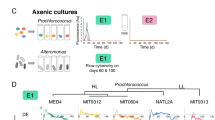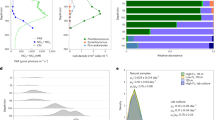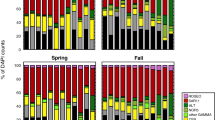Abstract
Subtropical oceanic gyres are the most extensive biomes on Earth where SAR11 and Prochlorococcus bacterioplankton numerically dominate the surface waters depleted in inorganic macronutrients as well as in dissolved organic matter. In such nutrient poor conditions bacterioplankton could become photoheterotrophic, that is, potentially enhance uptake of scarce organic molecules using the available solar radiation to energise appropriate transport systems. Here, we assessed the photoheterotrophy of the key microbial taxa in the North Atlantic oligotrophic gyre and adjacent regions using 33P-ATP, 3H-ATP and 35S-methionine tracers. Light-stimulated uptake of these substrates was assessed in two dominant bacterioplankton groups discriminated by flow cytometric sorting of tracer-labelled cells and identified using catalysed reporter deposition fluorescence in situ hybridisation. One group of cells, encompassing 48% of all bacterioplankton, were identified as members of the SAR11 clade, whereas the other group (24% of all bacterioplankton) was Prochlorococcus. When exposed to light, SAR11 cells took 31% more ATP and 32% more methionine, whereas the Prochlorococcus cells took 33% more ATP and 34% more methionine. Other bacterioplankton did not demonstrate light stimulation. Thus, the SAR11 and Prochlorococcus groups, with distinctly different light-harvesting mechanisms, used light equally to enhance, by approximately one-third, the uptake of different types of organic molecules. Our findings indicate the significance of light-driven uptake of essential organic nutrients by the dominant bacterioplankton groups in the surface waters of one of the less productive, vast regions of the world’s oceans—the oligotrophic North Atlantic subtropical gyre.
Similar content being viewed by others
Log in or create a free account to read this content
Gain free access to this article, as well as selected content from this journal and more on nature.com
or
References
Alonso-Saez L, Gasol JM, Lefort T, Hofer J, Sommaruga R . (2006). Effect of natural sunlight on bacterial activity and differential sensitivity of natural bacterioplankton groups in northwestern Mediterranean coastal waters. Appl Environ Microbiol 72: 5806–5813.
Amann R, Fuchs BM . (2008). Single-cell identification in microbial communities by improved fluorescence in situ hybridization techniques. Nat Rev Microbiol 6: 339–348.
Ammerman JW, Azam F . (1985). Bacterial 5′-Nucleotidase in aquatic ecosystems—a novel mechanism of phosphorus regeneration. Science 227: 1338–1340.
Beja O, Aravind L, Koonin EV, Suzuki MT, Hadd A, Nguyen LP et al (2000). Bacterial rhodopsin: evidence for a new type of phototrophy in the sea. Science 289: 1902–1906.
Beja O, Suzuki MT . (2008). Photohetrotrophic marine prokaryotes. In: Kirchman DL (ed) Microbial Ecology of the Oceans, 2nd edn. John Wiley & Sons, Inc., pp 132–157.
Beja O, Suzuki MT, Heidelberg JF, Nelson WC, Preston CM, Hamada T et al (2002). Unsuspected diversity among marine aerobic anoxygenic phototrophs. Nature 415: 630–633.
Bengis-Garber C . (1983). Uptake of adenosine in a marine bacterium is not an active-transport process. FEBS Lett 160: 31–36.
Bengis-Garber C . (1985). Membrane-bound 5′-Nucleotidase in marine luminous bacteria—biochemical and immunological properties. Can J Microbiol 31: 543–548.
Bengis-Garber C, Kushner DJ . (1982). Role of membrane-bound 5′-nucleotidase in nucleotide uptake by the moderate halophile Vibrio costicola. J Bacteriol 149: 808–815.
Campbell BJ, Waidner LA, Cottrell MT, Kirchman DL . (2008). Abundant proteorhodopsin genes in the North Atlantic Ocean. Environ Microbiol 10: 99–109.
Casey JR, Lomas MW, Michelou VK, Dyhrman ST, Orchard ED, Ammerman JW et al (2009). Phytoplankton taxon-specific orthophosphate (Pi) and ATP utilization in the western subtropical North Atlantic. Aquat Microb Ecol 58: 31–44.
Chapman AG, Atkinson DE . (1977). Adenine nucleotide concentrations and turnover rates. Their correlation with biological activity in bacteria and yeast. Adv Microb Physiol 15: 253–306.
Chisholm SW, Frankel SL, Goericke R, Olson RJ, Palenik B, Waterbury JB et al (1992). Prochlorococcus marinus nov. gen. nov. sp.: an oxyphototrophic marine prokaryote containing divinyl chlorophyll a and chlorophyll b. Arch Microbiol 157: 297–300.
Chisholm SW, Olson RJ, Zettler ER, Goericke R, Waterbury JB, Welschmeyer NA . (1988). A novel free-living prochlorophyte abundant in the oceanic euphotic zone. Nature 334: 340–343.
Church MJ, Ducklow HW, Karl DA . (2004). Light dependence of [3H]leucine incorporation in the oligotrophic North Pacific Ocean. Appl Environ Microbiol 70: 4079–4087.
Cottrell MT, Kirchman DL . (2009). Photoheterotrophic microbes in the Arctic Ocean in summer and winter. Appl Environ Microbiol 75: 4958–4966.
Cuhel RL, Waterbury JB . (1984). Biochemical composition and short term nutrient incorporation patterns in a unicellular marine cyanobacterium, Synechococcus (WH7803). Limnol Oceanogr 29: 370–374.
Daugherty RM, Linka N, Audia JP, Urbany C, Neuhaus HE, Winkler HH . (2004). The nucleotide transporter of Caedibacter caryophilus exhibits an extended substrate spectrum compared to the analogous ATP/ADP translocase of Rickettsia prowazekii. J Bacteriol 186: 3262–3265.
Fuchs BM, Glockner FO, Wulf J, Amann R . (2000). Unlabeled helper oligonucleotides increase the in situ accessibility to 16S rRNA of fluorescently labeled oligonucleotide probes. Appl Environ Microbiol 66: 3603–3607.
Fuhrman JA, Schwalbach MS, Stingl U . (2008). Opinion—Proteorhodopsins: an array of physiological roles? Nat Rev Microbiol 6: 488–494.
Gilbert JA, Muhling M, Joint I . (2008). A rare SAR11 fosmid clone confirming genetic variability in the ‘Candidatus Pelagibacter ubique’ genome. ISME J 2: 790–793.
Giovannoni SJ, Bibbs L, Cho JC, Stapels MD, Desiderio R, Vergin KL et al (2005a). Proteorhodopsin in the ubiquitous marine bacterium SAR11. Nature 438: 82–85.
Giovannoni SJ, Tripp HJ, Givan S, Podar M, Vergin KL, Baptista D et al (2005b). Genome streamlining in a cosmopolitan oceanic bacterium. Science 309: 1242–1245.
Hartmann M, Grob C, Tarran GA, Martin AP, Burkill PH, Scanlan DJ et al (2012). Mixotrophic basis of Atlantic oligotrophic ecosystems. Proc Natl Acad Sci USA 109: 5756–5760.
Hill PG, Zubkov MV, Purdie DA . (2010). Differential responses of Prochlorococcus and SAR11 dominated bacterioplankton groups to atmospheric dust inputs in the tropical Northeast Atlantic Ocean. FEMS Microbiol Lett 306: 82–89.
Karl DM, Hebel DV, Bjorkman K, Letelier RM . (1998). The role of dissolved organic matter release in the productivity of the oligotrophic North Pacific Ocean. Limnol Oceanogr 43: 1270–1286.
Kathuria S, Martiny AC . (2011). Prevalence of a calcium-based alkaline phosphatase associated with the marine cyanobacterium Prochlorococcus and other ocean bacteria. Environ Microbiol 13: 74–83.
Kirchman DL, Hanson TE . (2012). Bioenergetics of photoheterotrophic bacteria in the oceans. Environ Microbiol Rep.
Madigan MT . (2012) Brock Biology of Microorganisms, 13th edn. Benjamin Cummings: San Francisco.
Malmstrom RR, Kiene RP, Cottrell MT, Kirchman DL . (2004). Contribution of SAR11 bacteria to dissolved dimethylsulfoniopropionate and amino acid uptake in the North Atlantic ocean. Appl Environ Microbiol 70: 4129–4135.
Marie D, Partensky F, Jacquet S, Vaulot D . (1997). Enumeration and cell cycle analysis of natural populations of marine picoplankton by flow cytometry using the nucleic acid stain SYBR Green I. Appl Environ Microbiol 63: 186–193.
Mary I, Heywood JL, Fuchs BM, Amann R, Tarran GA, Burkill PH et al (2006). SAR11 dominance among metabolically active low nucleic acid bacterioplankton in surface waters along an Atlantic Meridional Transect. Aquat Microb Ecol 45: 107–113.
Mary I, Tarran GA, Warwick PE, Terry MJ, Scanlan DJ, Burkill PH et al (2008). Light enhanced amino acid uptake by dominant bacterioplankton groups in surface waters of the Atlantic Ocean. FEMS Microbiol Ecol 63: 36–45.
Michelou VK, Cottrell MT, Kirchman DL . (2007). Light-stimulated bacterial production and amino acid assimilation by cyanobacteria and other microbes in the North Atlantic Ocean. Appl Environ Microbiol 73: 5539–5546.
Michelou VK, Lomas MW, Kirchman DL . (2011). Phosphate and adenosine-5′-triphosphate uptake by cyanobacteria and heterotrophic bacteria in the Sargasso Sea. Limnol Oceanogr 56: 323–332.
Moore LR, Ostrowski M, Scanlan DJ, Feren K, Sweetsir T . (2005). Ecotypic variation in phosphorus acquisition mechanisms within marine picocyanobacteria. Aquat Microb Ecol 39: 257–269.
Morris RM, Rappe MS, Connon SA, Vergin KL, Siebold WA, Carlson CA et al (2002). SAR11 clade dominates ocean surface bacterioplankton communities. Nature 420: 806–810.
Pernthaler A, Pernthaler J, Amann R . (2004). Sensitive multicolor fluorescence in situ hybridization for the identification of environmental microorganisms. In: Kowalchuk G, de Bruijn FJ, Head IM, Akkermans ADL, van Elsas JD (eds) Molecular Microbial Ecology Manual, 2nd edn. Kluwer Academic Publishers: Dordrecht, The Netherlands, pp 711–726.
Rappe MS, Connon SA, Vergin KL, Giovannoni SJ . (2002). Cultivation of the ubiquitous SAR11 marine bacterioplankton clade. Nature 418: 630–633.
Ruiz-Gonzalez C, Simo R, Vila-Costa M, Sommaruga R, Gasol JM . (2012). Sunlight modulates the relative importance of heterotrophic bacteria and picophytoplankton in DMSP-sulphur uptake. ISME J 6: 650–659.
Scanlan DJ, Ostrowski M, Mazard S, Dufresne A, Garczarek L, Hess WR et al (2009). Ecological genomics of marine picocyanobacteria. Microbiol Mol Biol Rev 73: 249–299.
Schattenhofer M, Wulf J, Kostadinov I, Glockner FO, Zubkov MV, Fuchs BM . (2011). Phylogenetic characterisation of picoplanktonic populations with high and low nucleic acid content in the North Atlantic Ocean. Syst Appl Microbiol 34: 470–475.
Schmitz-Esser S, Linka N, Collingro A, Beier CL, Neuhaus HE, Wagner M et al (2004). ATP/ADP translocases: a common feature of obligate intracellular amoebal symbionts related to Chlamydiae and Rickettsiae. J Bacteriol 186: 683–691.
Sebastian M, Ammerman JW . (2011). Role of the phosphatase PhoX in the phosphorus metabolism of the marine bacterium Ruegeria pomeroyi DSS-3. Environ Microbiol Rep 3: 535–542.
Sebastian M, Pitta P, Gonzalez JM, Thingstad TF, Gasol JM . (2012). Bacterioplankton groups involved in the uptake of phosphate and dissolved organic phosphorus in a mesocosm experiment with P-starved Mediterranean waters. Environ Microbiol.
Steindler L, Schwalbach MS, Smith DP, Chan F, Giovannoni SJ . (2011). Energy starved Candidatus Pelagibacter ubique substitutes light-mediated ATP production for endogenous carbon respiration. PLoS One 6.
Wanner BL . (1996). Phosphorus assimilation and control of the phosphate regulon. In: Neidhardt FC, Curtiss R III, Ingra-Ham JL, Lin ECC, Low KB, Magasanik B et al. (eds) Escherichia coli and Salmonella: Cellular and Molecular Biology. ASM Press: Washington, DC, pp 1357–1381.
Waterbury JB, Watson SW, Guillard RRL, Brand LE . (1979). Widespread occurrence of a unicellular, marine, planktonic, cyanobacterium. Nature 277: 293–294.
West NJ, Schonhuber WA, Fuller NJ, Amann RI, Rippka R, Post AF et al (2001). Closely related Prochlorococcus genotypes show remarkably different depth distributions in two oceanic regions as revealed by in situ hybridization using 16S rRNA-targeted oligonucleotides. Microbiology 147: 1731–1744.
Willey JM, Waterbury JB . (1989). Chemotaxis toward nitrogenous compounds by swimming strains of marine Synechococcus spp. Appl Environ Microbiol 55: 1888–1894.
Winn CD, Karl DM . (1984). Laboratory calibrations of the [3H]adenine technique for measuring rates of RNA and DNA synthesis in marine microorganisms. Appl Environ Microbiol 47: 835–842.
Zubkov MV . (2009). Photoheterotrophy in marine prokaryotes. J Plankton Res 31: 933–938.
Zubkov MV, Burkill PH . (2006). Syringe pumped high speed flow cytometry of oceanic phytoplankton. Cytometry A 69: 1010–1019.
Zubkov MV, Fuchs BM, Tarran GA, Burkill PH, Amann R . (2003). High rate of uptake of organic nitrogen compounds by Prochlorococcus cyanobacteria as a key to their dominance in oligotrophic oceanic waters. Appl Environ Microbiol 69: 1299–1304.
Zubkov MV, Mary I, Woodward EMS, Warwick PE, Fuchs BM, Scanlan DJ et al (2007). Microbial control of phosphate in the nutrient-depleted North Atlantic subtropical gyre. Environ Microbiol 9: 2079–2089.
Zubkov MV, Sleigh MA, Burkill PH, Leakey RJG . (2000). Picoplankton community structure on the Atlantic Meridional Transect: a comparison between seasons. Prog Oceanogr 45: 369–386.
Zubkov MV, Tarran GA, Fuchs BM . (2004). Depth related amino acid uptake by Prochlorococcus cyanobacteria in the Southern Atlantic tropical gyre. FEMS Microbiol Ecol 50: 153–161.
Acknowledgements
We thank the captains, officers and crew aboard the Royal Research Ship James Cook and the Royal Research Ship Discovery for their help during both cruises. We are grateful to J Wulf for advice on FISH analyses. This study was supported by the UK Natural Environment Research Council through Research grants NE/H005196/1 and NE/H007083/1, as well as NE/E016138/1, NE/G005125/1, the Oceans 2025 Core Programme of the National Oceanography Centre and Plymouth Marine Laboratory and the European Commission Seventh Framework Programme through the GreenSeas Collaborative Project (FP7-ENV-2010 contract 265294). This is Atlantic Meridional Transect publication no. 224.
Author information
Authors and Affiliations
Corresponding author
Additional information
Supplementary Information accompanies the paper on The ISME Journal website
Supplementary information
Rights and permissions
About this article
Cite this article
Gómez-Pereira, P., Hartmann, M., Grob, C. et al. Comparable light stimulation of organic nutrient uptake by SAR11 and Prochlorococcus in the North Atlantic subtropical gyre. ISME J 7, 603–614 (2013). https://doi.org/10.1038/ismej.2012.126
Received:
Revised:
Accepted:
Published:
Issue date:
DOI: https://doi.org/10.1038/ismej.2012.126
Keywords
This article is cited by
-
Mixotrophy in marine picocyanobacteria: use of organic compounds by Prochlorococcus and Synechococcus
The ISME Journal (2020)
-
Accumulation of ambient phosphate into the periplasm of marine bacteria is proton motive force dependent
Nature Communications (2020)
-
Global genetic capacity for mixotrophy in marine picocyanobacteria
The ISME Journal (2016)
-
Prochlorococcus: the structure and function of collective diversity
Nature Reviews Microbiology (2015)
-
Dominant oceanic bacteria secure phosphate using a large extracellular buffer
Nature Communications (2015)



